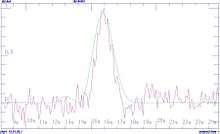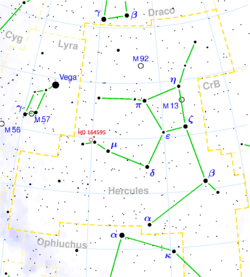HD 164595
| Observation data Epoch J2000 Equinox J2000 | |
|---|---|
| Constellation | Hercules |
| Right ascension | 18h 00m 38.894s[1] |
| Declination | +29° 34′ 18.92″[1] |
| Apparent magnitude (V) | 7.08[2] |
| Characteristics | |
| Spectral type | G2V D[1] |
| Details | |
| Mass | 0.99[3] M☉ |
| Surface gravity (log g) | 4.44 ± 0.05[3] cgs |
| Temperature | 5790 ± 40[3] K |
| Metallicity [Fe/H] | −0.06[3] dex |
| Age | 4.5[3] Gyr |
| Other designations | |
| Database references | |
| SIMBAD | data |
| Data sources: | |
| Hipparcos Catalogue | |
HD 164595[1] is a G-type star located in the constellation of Hercules, 28.927 parsecs (94.35 light-years) from Earth that is notably similar to the Sun.[3][4] With an apparent magnitude of 7.075,[1] the star can be found with binoculars or a small telescope in the constellation Hercules.
HD 164595 has one known planet, HD 164595 b, which orbits HD 164595 every 40 days.[5] The planet has a mass equivalent of 16 Earths.[5]
It is the same stellar classification as the Sun: G2V. It has a similar temperature, at 5790 K compared with 5778 K for the Sun. It has a lower logarithm of metallicity ratio, at −0.06 compared with 0.00, and a slightly younger age, at 4.5 versus 4.6 billion years.[6][7][lower-alpha 1]
In 2016, HD 164595 briefly attracted media attention after it was reported that a possible SETI signal had been detected from the direction of the star in the previous year. The signal was only heard once and never confirmed by other telescopes, and is thought to have been due to terrestrial interference.
Signal observation and SETI

On 15 May 2015, a brief, single radio signal at 11 GHz (2.7 cm wavelength)[9] was observed in the direction of HD 164595 by a team led by N. N. Bursov[10] involving Claudio Maccone at the RATAN-600 radio observatory. The signal may be due to terrestrial radio-frequency interference or gravitational lensing from a more distant source.[11][12] It was observed only once (for two seconds), by a single team, at a single telescope, giving it a Rio Scale[13] score of 1 (insignificant) or 2 (low). Discussions in the media from 29 August 2016 onwards featured speculation that the signal could be caused by an isotropic beacon from a Type II civilization.[14][15]
The senior astronomer of the SETI Institute, Seth Shostak, stated that confirmation by another telescope is required.[16] Astronomer Nicholas Suntzeff of Texas A&M University stated that the signal is in a military frequency band, and that it could have been a satellite downlink, implying that some such systems may be kept secret and therefore would be unknown to SETI scientists.[9]
SETI and METI studies followed with the Allen Telescope Array and the Boquete Optical SETI Observatory.[17][16] Also, scientists at Berkeley SETI Research Center at the University of California, Berkeley observed HD 164595 using the Green Bank Telescope as part of the Breakthrough Listen program. No signal was detected at the position and frequency of the transient reported by the RATAN group.[18][19]
The Special Astrophysical Observatory of the Russian Academy of Sciences has since released an official statement that the signal is of a "most probable terrestrial origin".[20]
Sun comparison
This chart compares the Sun to HD 164595.
| Identifier | J2000 Coordinates | Distance (ly) |
Stellar class |
Temperature (K) |
Metallicity (dex) |
Age (Gyr) |
Notes | |
|---|---|---|---|---|---|---|---|---|
| Right ascension | Declination | |||||||
| Sun | — | — | 0 | G2V | 5778 | +0.00 | 4.6 | [7] |
| HD 164595[1] | 18h 00m 38.9s | +29° 34′ 19″ | 91 | G2V | 5790 | −0.06 | 4.5 | [6] |
See also
- Arecibo message, a 3-minute-long message sent into space
- KIC 8462852, "Tabby's star"
- Wow! signal, possible alien radio signal
- HD 162826
Footnotes
- ↑ An exact solar twin would be a G2V star with a 5778 K temperature, be 4.6 billion years old, with the correct metallicity and a 0.1% solar luminosity variation.[8][7]
References
- 1 2 3 4 5 6 "HD 164595 – Star". SIMBAD. Centre de données astronomiques de Strasbourg. Retrieved 13 July 2016.
- ↑ Epps, E. A. (1972). "UBV photoelectric observations: I. Stars within 25 parsec of the sun; II. Stars in quasar and galaxy fields; III. Stars in Kapteyn Selected Areas; IV. Miscellaneous stars". Royal Observatory Bulletin. 176: 127. Bibcode:1972RGOB..176..127E.
- 1 2 3 4 5 6 "A photometric and spectroscopic survey of solar twin stars within 50 parsecs of the Sun page 7 & 11 & 17, 31 December 2013". Cornell University - Astronomy & Astrophysics manuscript. arXiv:1312.7571
 . Bibcode:2014A&A...563A..52P. doi:10.1051/0004-6361/201322277.
. Bibcode:2014A&A...563A..52P. doi:10.1051/0004-6361/201322277. - ↑ "HD 164595 - Star - SKY-MAP".
- 1 2 "HD 164595 b Confirmed Planet Overview Page". NASA. Retrieved 31 August 2016.
- 1 2 Porto de Mello, G. F.; da Silva, R.; da Silva, L.; de Nader, R. V. (March 2014). "A photometric and spectroscopic survey of solar twin stars within 50 parsecs of the Sun; I. Atmospheric parameters and color similarity to the Sun". Astronomy and Astrophysics. 563: A52. arXiv:1312.7571
 . Bibcode:2014A&A...563A..52P. doi:10.1051/0004-6361/201322277.
. Bibcode:2014A&A...563A..52P. doi:10.1051/0004-6361/201322277. - 1 2 3 Williams, D. R. (2004). "Sun Fact Sheet". NASA. Retrieved 23 June 2009.
- ↑ "Solar Variability and Terrestrial Climate - NASA Science". Retrieved 8 January 2013.
- 1 2 Berger, Eric. "Ars Technica". Ars Technica. Ars Technica. Retrieved 29 August 2016.
- ↑ Gilster, Paul (27 August 2016). "An Interesting SETI Candidate in Hercules". Centauri Dreams. Retrieved 29 August 2016.
- ↑ Bursov, N.; Filippova, L.; Filippov, V.; Gindilis, L.; Maccone, C.; et al. (2016). "SETI observations on the RATAN-600 telescope in 2015 and detection of a strong signal in the direction of HD 164595". IAA SETI Permanent Committee. Guadalajara, Mexico.
- ↑ "Mystery radio signal may be from distant star system — or a military transmitter". KurzweilAI. 29 August 2016. Retrieved 31 August 2016.
- ↑ "Rio scale calculator".
- ↑ Seemangal, Robin (29 August 2016). "Not a Drill: SETI Is Investigating a Possible Extraterrestrial Signal From Deep Space". Retrieved 29 August 2016.
- ↑ Zolfagharifard, Ellie (29 August 2016). "Is Earth being contacted by ALIENS? Mystery radio signals coming from a Sun-like star baffle scientists". Retrieved 29 August 2016.
- 1 2 "They're not saying it's aliens, but signal traced to sunlike star sparks SETI interest". 29 August 2016.
- ↑ "'Leaked' space signal report has SETI groups scrambling".
- ↑ "Preliminary analysis of star HD 164595" (PDF).
- ↑ "Breakthrough Listen Follow-up of a Transient Signal from the RATAN-600 Telescope in the Direction of HD 164595" (PDF).
- ↑ "SETI".
Coordinates: ![]() 18h 00m 38.894s, +29° 34′ 18.92″
18h 00m 38.894s, +29° 34′ 18.92″
